
A brief overview of the history of copyright laws and why the Creative Commons was right on time!
- Subject:
- Applied Science
- Information Science
- Material Type:
- Module
- Reading
- Author:
- Tess Beebe Olten
- Date Added:
- 03/30/2021


A brief overview of the history of copyright laws and why the Creative Commons was right on time!
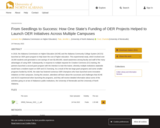
In 2018, the Alabama Commission on Higher Education (ACHE) and the Alabama Community College System (ACCS) launched an OER grant program to help lower the cost of higher education. This experimental study, which involved over 18,000 students and generated a cost savings of over $2,000,000, raised awareness among faculty and staff of the many advantages of using OER. Subsequently, in response to multiple requests for Creative Commons (CC) training, the partners launched a second grant program with the intention to train-the-trainer, whereby multiple institutions statewide would have a resident expert on OER and CC licensing. As a result of the two large grant programs and some smaller programs funded by ACHE, the state has fostered numerous OER champions who have launched some innovative initiatives on their campuses. During this session, attendees will learn about the successes and challenges that ACHE and ACCS experienced when launching the programs, and they will receive detailed information about some of the activities going on at two of Alabama’s public institutions, the University of Montevallo and the University of North Alabama.

Where does our money go? Who are the beneficiaries of public funding? Which projects get funded? When and how do publicly funded projects deliver concrete results? Are they effective enough? The Scuola di OpenCoesione (ASOC) is an educational challenge and a MOOC (Massive Online Open Course), designed for Italian high-school students.
It has three main objectives. First, to find out how public money is spent in a given local area or neighbourhood; second, to follow the projects and investigate how they are progressing and what challenges are they facing and third, to involve local communities in monitoring the effectiveness of public investment.
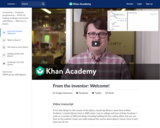
Meet John Resig, the developer that invented jQuery and now works as an engineer at Khan Academy.

Gordon Moore, co-founder of Intel Corporation, to whom the term "Moore's Law" is attributed, speaks about the ubiquitous microchip. (27 minutes)

Noted scientist Stephen Wolfram shares his perspective of how the unexpected results of simple computer experiments have forced him to consider a whole new way of looking at processes in our universe. (86 minutes)
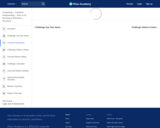
Pamela shows how you can pass parameters into custom functions, so that they can behave differently each time you call them.
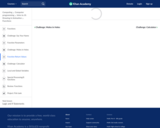
Pamela explains how to return values from functions, especially useful in doing calculations.
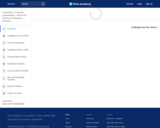
Pamela explains how you can write your own custom functions to group your code and make it more reusable.

This video contains module wise discussion about fundamentals of computer and its application. Some assignments are also there for practice

This course on "Future Internet Opportunities" consists of 10 modules, which are related to the subject from technical, social and business perspectives.
Each module is available at introductory, basic and advanced levels.
The material is developed as part of an Erasmus+ Strategic Partnership, and available for everyone to use, exploit and modify. The materials consist of a wide variety of materials: From Powerpoint slides, to interactive materials with videos and quizzes, assignments, and peer learning activities.

The freely accessible moodle platform offers a number of insights into past proejct work as well as a documentation of the results that were achieved in the course of the project.

Modelo de GDD (Game Design Document), material de apoio do framework PC-Game.
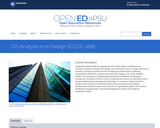
Geography 468 provides the geospatial information system professional an overview of systems analysis and design with emphasis on the concepts behind the process, including: business use case modeling, business object modeling, requirements definition, analysis and preliminary design, and, finally, detailed design. The concepts of the geospatial software and database development process are introduced and the current modeling techniques are addressed within the geospatial systems development paradigm. In a series of related activities, students learn about the methods, tools and the concepts of the systems development process to document a portion of a geospatial system with Unified Modeling Language (UML), the standard graphical notation for modeling application needs.
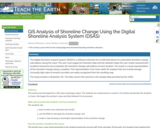
The Digital Shoreline Analysis System (DSAS) is a software extension for ArcGIS that allows for automated shoreline change calculations along the coast. The user must supply the shoreline data and the software helps the user create measurement locations (transects) and completes the shoreline change calculations at each location. The result is a visual representation of the shoreline change along a coastline. This representation is far more useful for analysis that one overall average. Unusually high rates of erosion/accretion are easily recognized from the resulting map.
The study location is Rodanthe, NC. The data used in this exercise is the sample data provided by the USGS.
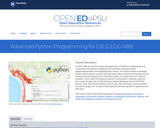
In GEOG 489, you will learn advanced applications of Python for developing and customizing GIS software, designing user interfaces, solving complex geoprocessing tasks, and leveraging open source. The course consists of readings, walkthroughs, projects, quizzes, and discussions about advanced GIS programming concepts and techniques, and a final term project. It complements the material covered in GEOG 485: GIS Programming and Customization. Software covered in the course includes: Esri ArcGIS Pro/arcpy, Jupyter Notebook, Esri ArcGIS API for Python, QGIS, GDAL/OGR. Students will also use of the Git version control software for code management, and learn techniques for distributing Python applications to end users.
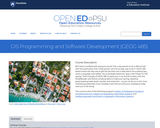
Bill Gates is credited with saying he would \hire a lazy person to do a difficult job\" with the justification that \"a lazy person will find an easy way to do it.\" GEOG 485 doesn't teach the lazy way to get the job done, but it does teach the scripting way _ which is arguably even better. You've probably heard the \"give a fish\"/\"teach to fish\" saying? That's the gist of GEOG 485: to equip you, in an ArcGIS context, with the ModelBuilder and Python scripting skills to make your boring, repetitive geoprocessing tasks easier, quicker and automatic _ so you can focus on the more interesting (potentially more valuable) work that you (and your employers) really want you to be doing."
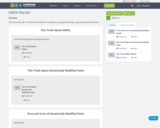
Text set to pair with "The Omnivore's Dilemma" to address an argument prompt on genetically modified foods.

LINEAR TRANSFORMATIONs ON THE PLAIN .
INTRODUCTION TO ISOHEDRALS , BASIC BLOCKS TO SYMMETRIC TILING.
TESSELLATIONs (PERIODIC & APERIODIC)
.
BRENIKOU , MACEDONIA EAST , HELLAS (GREECE).ARTIST (PAINTER & SCULPTOR) : EFSTRATOPOULOS NIKOLAOS ( efstrato71@gmail.com )MUSIC : Εύελδωρ - Λυρογηθής (ANCIEN...
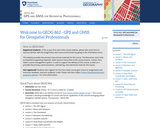
Today GPS is critical to positioning, navigation, and timing. The smooth functioning of financial transactions, air traffic, ATMs, cell phones and modern life in general around the world depend on GPS. This very criticality requires continuous modernization. The oldest satellites in the current constellation were launched in the 1990s. If you imagine using a computer of that vintage today, it is not surprising that the system is being substantially updated. Global Positioning System (GPS) is now a part of a growing international con?text-the Global Navigation Satellite System, GNSS. This course dives into how GPS and other GNSS systems are designed, how they operate, and the impacts they have on spatial analysis and spatially-enabled systems.